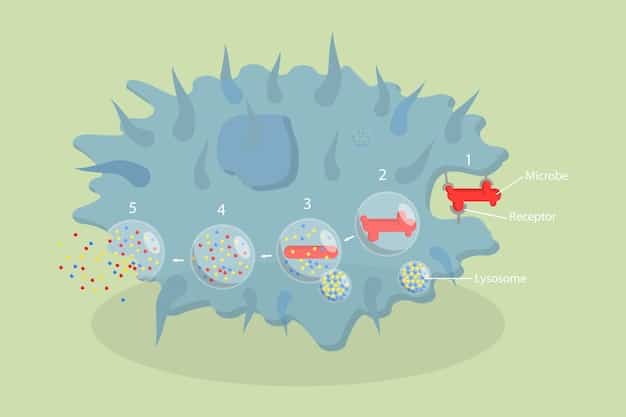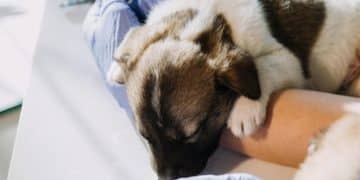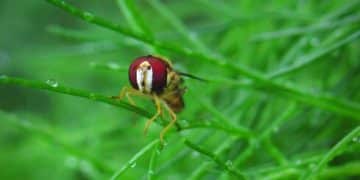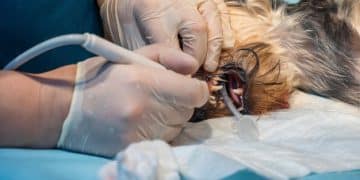Protect Your Puppy: A Comprehensive Guide to Parvo and Distemper

Protecting your puppy from parvovirus and distemper involves vaccination, hygiene, and awareness of the signs of infection: early prevention and prompt veterinary care are critical to ensuring your puppy’s health and survival.
Bringing a new puppy into your home is a joyous occasion. However, it’s also a time when you need to be extra vigilant about their health, especially when it comes to highly contagious and potentially deadly diseases like parvovirus and distemper. This guide provides essential information on how to protect your puppy: a guide to preventing parvovirus and distemper.
Understanding Parvovirus and Distemper
Parvovirus and distemper are two of the most serious and common diseases affecting puppies. Both are viral infections that can cause severe illness and even death, particularly in young, unvaccinated dogs. Knowing what these diseases are and how they spread is the first step in protecting your new furry friend.
What is Parvovirus?
Parvovirus, often simply called “parvo,” is a highly contagious viral disease that affects the gastrointestinal tract of puppies. It’s spread through direct contact with infected dogs or indirectly through contaminated environments, such as soil, food bowls, and even shoes. The virus is extremely resilient and can survive in the environment for months, making it a significant threat.
Symptoms of parvo typically appear within 3 to 10 days after exposure and can include severe vomiting, diarrhea (often bloody), lethargy, loss of appetite, and dehydration. Puppies are particularly vulnerable because their immune systems are not fully developed, and the rapid onset of dehydration can quickly become life-threatening.
What is Distemper?
Distemper, on the other hand, affects multiple systems in the body, including the respiratory, gastrointestinal, and nervous systems. It’s spread through airborne exposure, such as coughing and sneezing but can also be found on surfaces similar to parvovirus. Distemper is less common than parvo due to widespread vaccination efforts, but it remains a significant concern, especially in areas with lower vaccination rates.
The symptoms of distemper are varied and can include fever, nasal discharge, coughing, vomiting, diarrhea, loss of appetite, and lethargy. As the disease progresses, neurological symptoms such as seizures, muscle twitching, and paralysis may develop. These neurological signs can lead to permanent damage, even if the puppy survives the initial infection.

- Parvovirus targets the gastrointestinal tract: Causing severe vomiting and diarrhea, leading to rapid dehydration.
- Distemper affects multiple systems: Including respiratory, gastrointestinal, and nervous systems, resulting in diverse symptoms.
- Both diseases are highly contagious: Spreading through direct contact, airborne particles, or contaminated environments.
- Vaccination is the most effective preventative measure: Protecting puppies from these potentially deadly viruses.
Understanding the specifics of parvovirus and distemper, their transmission routes, and the range of symptoms they can cause is crucial for responsible puppy ownership. Recognizing the signs early and seeking prompt veterinary care can dramatically improve a puppy’s chances of survival.
The Importance of Vaccination
Vaccination is a cornerstone of preventative care for puppies. It’s the most effective way to protect them from parvovirus and distemper, along with other dangerous diseases. The vaccination process helps build your puppy’s immunity, so they can fight off these infections if exposed.
Puppies receive initial immunity from their mother’s milk, known as maternal antibodies. However, this protection wanes over time, leaving the puppy vulnerable until they are vaccinated. A series of vaccinations is typically administered, starting around 6 to 8 weeks of age and continuing every 3 to 4 weeks until the puppy is about 16 weeks old.
Core Vaccines for Puppies
The core vaccines for puppies include those that protect against parvovirus, distemper, adenovirus (hepatitis), and parainfluenza. This combination is often referred to as the DHPP or DA2PP vaccine. Your veterinarian will recommend a vaccination schedule based on your puppy’s individual needs and risk factors. These core vaccines are vital for your puppy’s health.
The timing and frequency of booster shots are also important to maintain ongoing immunity. After the initial series, puppies typically receive a booster shot at one year of age, followed by boosters every one to three years, depending on the specific vaccine and local regulations. Consult with your veterinarian to determine the best booster schedule for your puppy.
When to Vaccinate
The ideal time to start vaccinating a puppy is around 6 to 8 weeks old. This is when maternal antibody protection starts to decrease, and the puppy becomes more susceptible to infections. The series of vaccinations continues every 3 to 4 weeks until the puppy is around 16 weeks old, ensuring they develop a strong and lasting immunity.
- Vaccination is the most effective protection: Providing immunity against parvovirus and distemper.
- Start vaccinations early: Begin the series at 6-8 weeks of age.
- Follow a veterinarian-recommended schedule: Ensure proper timing and boosters.
- Core vaccines are essential: DHPP or DA2PP protects against common and deadly diseases.
Vaccination is a critical step in ensuring your puppy’s health and well-being. By following a recommended vaccination schedule and staying vigilant about booster shots, you can provide your puppy with the best possible protection against parvovirus, distemper, and other serious diseases.
Maintaining a Clean and Safe Environment
Beyond vaccination, maintaining a clean and safe environment is paramount for protecting your puppy from parvovirus and distemper. These viruses can survive for extended periods in the environment, making it essential to take proactive steps to minimize exposure.
Regular cleaning and disinfection of areas where your puppy spends time can significantly reduce the risk of infection. This includes indoor spaces like floors, crates, and bedding, as well as outdoor areas such as yards and dog parks. Using appropriate disinfectants and following proper hygiene practices can help eliminate these viruses.
Effective Disinfectants
When cleaning and disinfecting, it’s important to use products that are effective against parvovirus and distemper. Bleach is a commonly recommended disinfectant for parvovirus because of its strength. A solution of 1 part bleach to 32 parts water is generally effective. Be sure to allow the disinfectant to sit on the surface for at least 10 minutes before rinsing to ensure complete disinfection.
For distemper, many common disinfectants used in veterinary clinics are effective. Always read and follow the manufacturer’s instructions when using any disinfectant, and ensure proper ventilation to avoid exposure to harmful fumes. Consider using pet-safe disinfectants to avoid poisoning.
Hygiene Practices
Good hygiene practices are crucial in preventing the spread of parvovirus and distemper. Always wash your hands thoroughly with soap and water after handling your puppy, especially before eating or preparing food. Clean and disinfect food and water bowls regularly to prevent contamination, and properly dispose of pet waste to prevent the spread of disease. This helps to keep your pet safe from harmful organisms.

- Regular cleaning and disinfection: Reduce the risk of viral exposure.
- Use effective disinfectants: Bleach solutions are effective against parvovirus.
- Practice good hygiene: Wash hands and clean pet supplies regularly.
- Proper waste disposal: Prevents the spread of disease.
Creating a clean and safe environment is an ongoing effort but a worthwhile investment in your puppy’s health. Regular cleaning, effective disinfection, and diligent hygiene practices can significantly reduce the risk of parvovirus and distemper, helping your puppy thrive.
Recognizing the Symptoms
Early recognition of symptoms is essential for timely intervention and improving your puppy’s chances of survival if they contract parvovirus or distemper. Knowing what to look for and acting quickly can make a significant difference.
Both parvovirus and distemper present with a range of symptoms, and it’s important to be vigilant and observe your puppy’s behavior and physical condition closely. If you notice any signs of illness, it’s crucial to consult with your veterinarian promptly for diagnosis and treatment.
Symptoms of Parvovirus
The hallmark symptoms of parvovirus include severe vomiting and diarrhea, which is often bloody. Puppies may also exhibit a loss of appetite, lethargy, and weakness. Dehydration can occur rapidly due to the loss of fluids from vomiting and diarrhea, making it critical to seek veterinary care immediately. Symptoms can be evident very quickly.
Other signs of parvovirus include a high fever or, conversely, a low body temperature. The puppy may also appear visibly weak and unwilling to move. Gums may be pale and tacky to the touch, indicating dehydration. Any combination of these symptoms should be considered an emergency. Consult your veterinarian immediately.
Symptoms of Distemper
Distemper presents with a broader range of symptoms that can affect multiple systems in the body. Early signs may include fever, nasal discharge, and coughing. As the disease progresses, puppies may develop vomiting, diarrhea, and loss of appetite. Look for these symptoms if you are worried about the health of your dog.
Neurological symptoms, such as seizures, muscle twitching, and paralysis, are common in advanced cases of distemper. The puppy may also exhibit behavioral changes such as disorientation or aggression. Hardening of the footpads (known as “hard pad disease”) is a classic sign of distemper, though not always present. These symptoms could also be something else but should be cause for concern.
- Parvovirus: Severe vomiting, bloody diarrhea, lethargy, and dehydration.
- Distemper: Fever, nasal discharge, coughing, vomiting, diarrhea, and neurological signs.
- Early recognition is crucial: Seek immediate veterinary care if you notice any symptoms.
- Monitor your puppy closely: Watch for changes in behavior and physical condition.
Being vigilant and recognizing the symptoms of parvovirus and distemper can significantly impact your puppy’s outcome. If you suspect your puppy may be ill, don’t hesitate to contact your veterinarian—early treatment is often the most effective way to combat these diseases.
Seeking Veterinary Care
Prompt veterinary care is crucial when a puppy shows signs of parvovirus or distemper. These diseases can progress rapidly, and early intervention is essential to improve the chances of survival. Knowing when and how to seek veterinary assistance can be life-saving.
If you suspect your puppy has contracted parvovirus or distemper, it is essential to seek veterinary care immediately. Do not wait to see if the symptoms improve on their own. These diseases can deteriorate a puppy’s health very quickly; any delay in treatment can have serious consequences.
Diagnostic Tests
Veterinarians use various diagnostic tests to confirm parvovirus and distemper infections. For parvovirus, a fecal test is commonly performed to detect the presence of the virus in the puppy’s stool. This test is quick, reliable, and can provide results within minutes. Results give a baseline to work from.
Diagnosing distemper can be more challenging, as the symptoms are varied, and there is no single definitive test. Veterinarians may use a combination of blood tests, urine tests, and neurological evaluations to assess the puppy’s condition. In some cases, a cerebrospinal fluid (CSF) tap may be necessary to evaluate for inflammation in the brain and spinal cord.
Treatment Options
Treatment for parvovirus and distemper is primarily supportive, focusing on managing symptoms and preventing secondary complications. For parvovirus, treatment typically involves intravenous fluids to combat dehydration, medications to control vomiting and diarrhea, and antibiotics to prevent bacterial infections. Hospitalization is usually necessary to provide intensive care.
- Seek immediate veterinary care: Don’t delay if you suspect your puppy is ill.
- Diagnostic tests: Fecal tests for parvovirus, blood tests, and neurological evaluations for distemper.
- Supportive treatment: IV fluids, medications, and antibiotics to manage symptoms.
- Hospitalization: Often necessary for intensive care and monitoring.
Seeking prompt veterinary care and following your veterinarian’s recommendations are critical steps in managing parvovirus and distemper. Early diagnosis and aggressive supportive treatment can significantly improve your puppy’s chances of recovery.
Long-Term Care and Prevention
Even after a puppy recovers from parvovirus or distemper, long-term care and prevention efforts are essential to ensure their continued health and well-being. These diseases can have lasting effects, and ongoing vigilance is necessary to protect your puppy from future infections.
Following recovery from parvovirus or distemper, puppies may require specific long-term care to address any lingering effects of the disease. This can include dietary management, physical therapy, and close monitoring for any recurring symptoms. Working closely with your veterinarian is crucial to develop a personalized care plan.
Dietary Management
Many puppies experience lingering digestive issues after recovering from parvovirus. Veterinarians often recommend a bland, easily digestible diet to help restore normal gastrointestinal function. This may include foods such as boiled chicken and rice, or specially formulated veterinary diets. Gradually reintroduce your puppy’s regular food over several days to prevent digestive upset. Do not introduce too many new foods at once so as not to upset the puppy’s stomach again.
Puppies who have suffered neurological damage from distemper may benefit from physical therapy to improve muscle strength and coordination. This can involve exercises such as range-of-motion activities, massage, and hydrotherapy. Regular physical therapy sessions can help improve mobility and quality of life.
Preventing Reinfection
To prevent re-infection, it’s crucial to maintain a clean and disinfected environment. Continue to use effective disinfectants to clean areas where your puppy spends time, and practice good hygiene to minimize the risk of exposure. Ensure that all other pets in the household are fully vaccinated to prevent the spread of disease.
| Key Point | Brief Description |
|---|---|
| 💉 Vaccination | Core vaccines protect puppies from parvo and distemper; essential for immunity. |
| 🧼 Clean Environment | Regularly disinfect areas with bleach to kill parvovirus and maintain hygiene. |
| 🚨 Early Detection | Recognize symptoms like vomiting, diarrhea, and lethargy for prompt treatment. |
| 🩺 Vet Care | Seek immediate veterinary help for diagnosis and supportive treatment. |
Frequently Asked Questions
▼
Recovery from parvo can take anywhere from one to three weeks, depending on the severity of the infection, the puppy’s age, and overall health. Proper supportive care, including IV fluids and medications, is essential for a full recovery.
▼
Adult dogs can contract parvovirus and distemper, but vaccinated adults are far less likely to become infected or experience severe symptoms. Booster shots every one to three years, as recommended by a vet, are important.
▼
There is no direct cure for distemper; treatment focuses on managing symptoms and preventing secondary infections. Supportive care, including fluids, antibiotics, and neurological support, is vital to improve the chances of survival. But, it is by no means guaranteed.
▼
To disinfect your yard after a parvo infection, use a bleach solution of 1 part bleach to 32 parts water on all surfaces. Be sure to rinse the treated areas after 10 minutes to prevent any harmful effects on plants or other animals.
▼
Yes, some dogs may experience long-term neurological issues, such as muscle twitching, seizures, or paralysis, even after recovering from distemper. Consistent care and consulting with your vet are critical to giving them the best care possible.
Conclusion
Protecting your puppy from parvovirus and distemper requires a comprehensive approach that includes vaccination, maintaining a clean environment, early symptom recognition, and prompt veterinary care. By taking these proactive steps, you can significantly improve your puppy’s chances of living a long, healthy, and happy life.





